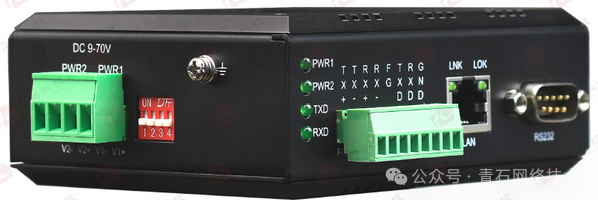In industrial production environments, it is often necessary to collect operational parameters of devices, such as power, temperature, pressure, and flow, through various sensors. The signal outputs collected are generally 4-20mA/0-10V 485 signals, which cannot be directly read by software platforms. Therefore, they need to be converted into TCP/IP signals. Devices that can achieve this functionality include serial port servers and communication management machines (also known as data acquisition gateways). However, the usage scenarios for these two are different, which will be discussed in detail below.1. Serial Port Server is a device that converts serial communication protocols into network protocols, allowing traditional serial devices to transmit data over Ethernet. This conversion not only extends the communication range of serial devices but also improves the real-time performance and reliability of data transmission. The product is shown in the figure below: Figure 1: Serial Port Server Image
Figure 1: Serial Port Server Image
The main technical parameters of the serial port server are as follows:
◆ 10/100M Ethernet Interface
Protocol: Complies with IEEE 802.3ab, IEEE 802.3z
Speed: 10/100 adaptive full/half duplex adaptive
MAC Address Table: Can learn 4096 MAC addresses
Physical Interface: RJ45 socket supports Auto-MDIX
◆ Serial Interface
Standard
EIA/TIA-232 RS-232 (ITU-T V.28)
EIA/TIA-422 RS-422 (ITU-T V.11)
EIA/TIA-485 RS-485 (ISO/IEC8284)
Serial Port Interface:
RS-422: TxD+ TxD- RxD+ RxD- GND
RS-485 4 wires: TxD+ TxD- RxD+ RxD- GND
RS-485 2 wires: A (corresponding to TX+) B (corresponding to TX-) GND
RS-232:
Terminal: RXD TXD GND
DB9 (male): RXD TXD GND, CTS, RTS
2. Communication Management Machine
The communication management machine (also known as the data acquisition gateway) is an intelligent device that integrates data acquisition, processing, communication, and control functions. It uses an embedded hardware computer platform, has multiple downstream communication interfaces, and one or more upstream network interfaces, serving as a bridge between the data acquisition terminal and the platform system in information acquisition systems. It can collect and summarize data from devices such as water meters, gas meters, electric meters, and microcomputer protection devices according to different acquisition protocols, and forward the data from field devices to the platform system using the corresponding protocols.The communication management machine can receive commands issued by the upper master station system and forward them to intelligent series units within the target area, completing remote control of various switch devices in the plant or parameter setting of devices, achieving remote control and remote adjustment functions to meet the goal of remote output scheduling commands.As a communication interface device between automation system networks and monitoring equipment, the communication management machine provides multiple functions such as protocol conversion, transparent forwarding, data encryption and compression, data conversion, and edge computing.The product is shown in the figure below: Figure 2: Communication Management Machine ImageIn simple terms, the communication management machine can not only achieve conversion of 485/232 data formats but also control front-end devices and perform protocol conversion and other functions, making it much more powerful than a serial port server.3. The main differences are as follows::
Figure 2: Communication Management Machine ImageIn simple terms, the communication management machine can not only achieve conversion of 485/232 data formats but also control front-end devices and perform protocol conversion and other functions, making it much more powerful than a serial port server.3. The main differences are as follows::
-
Serial Port Server: Only achieves transparent transmission from serial port (RS232/485) to Ethernet (e.g., Modbus RTU to TCP),without parsing protocol content. Data format conversion relies on upper computer software or additional development.
-
Communication Management Machine: Built-in multi-protocol parsing engine (e.g., Modbus, OPC UA, IEC104, DNP3, etc.), can directlydecode data packets, reorganize data structures, and convert to standard formats (e.g., JSON, MQTT), significantly reducing the processing burden on the upper computer.
- Disconnection Buffer and Data ResendingThe communication management machine is usually equipped with local storage (SD card or Flash) to cache data during network interruptions and resend it after recovery, preventing data loss; the serial port server does not have this function.Application scenarios are compared as follows:
 Figure 3: Comparison of Usage Scenarios for Serial Port Server and Communication Management Machine
Figure 3: Comparison of Usage Scenarios for Serial Port Server and Communication Management Machine